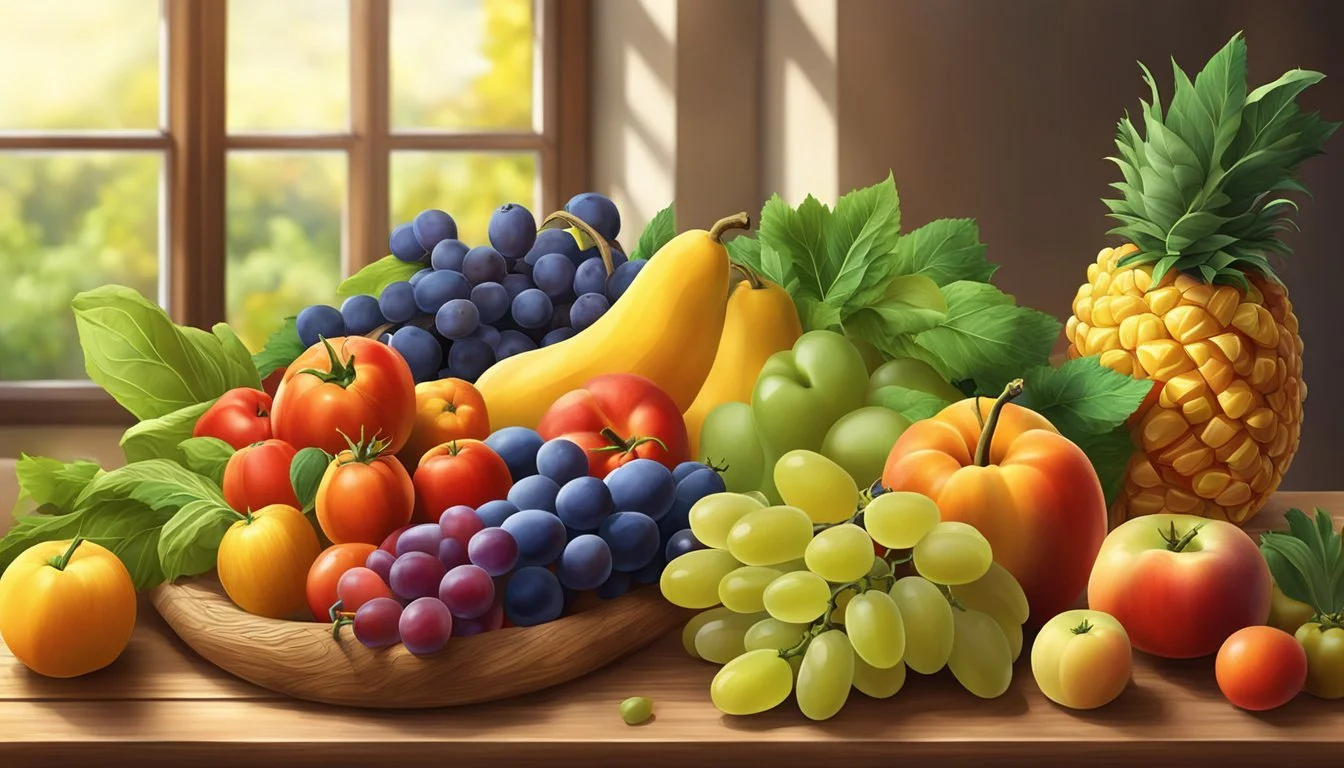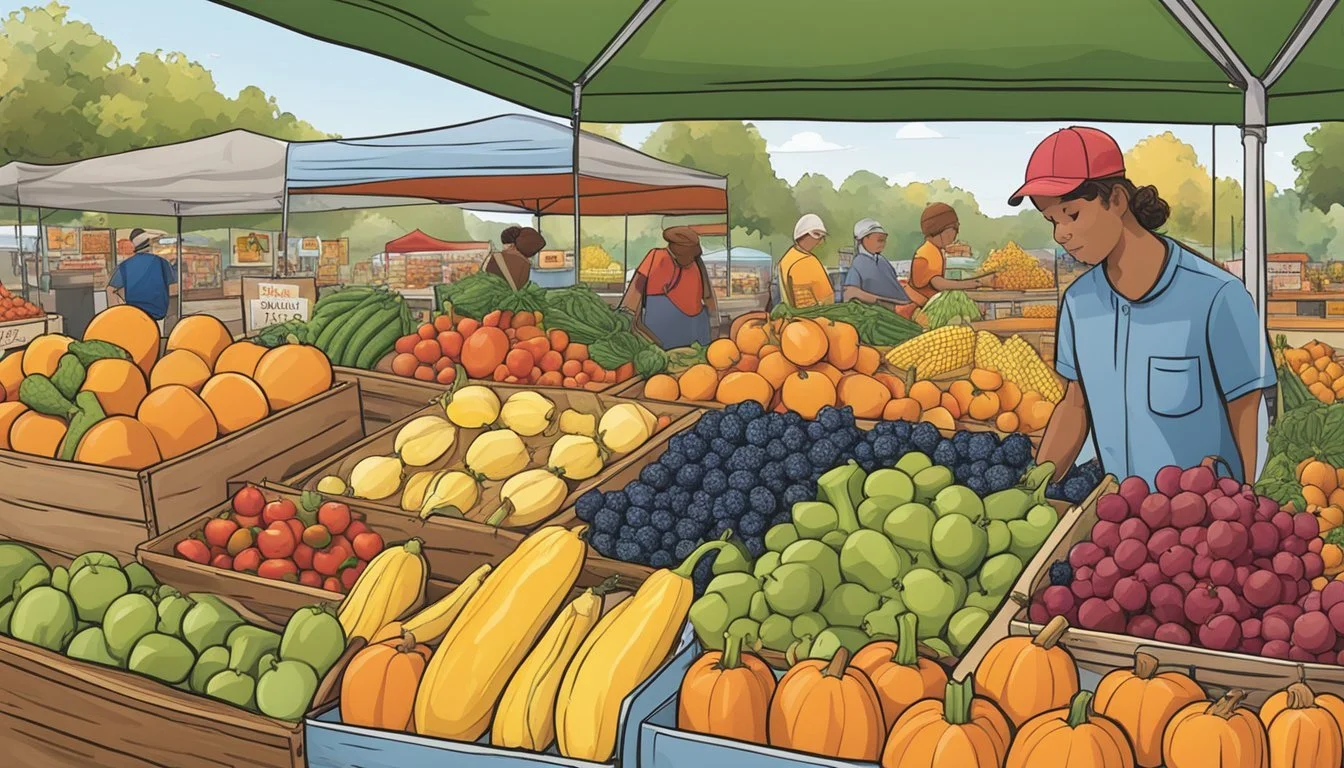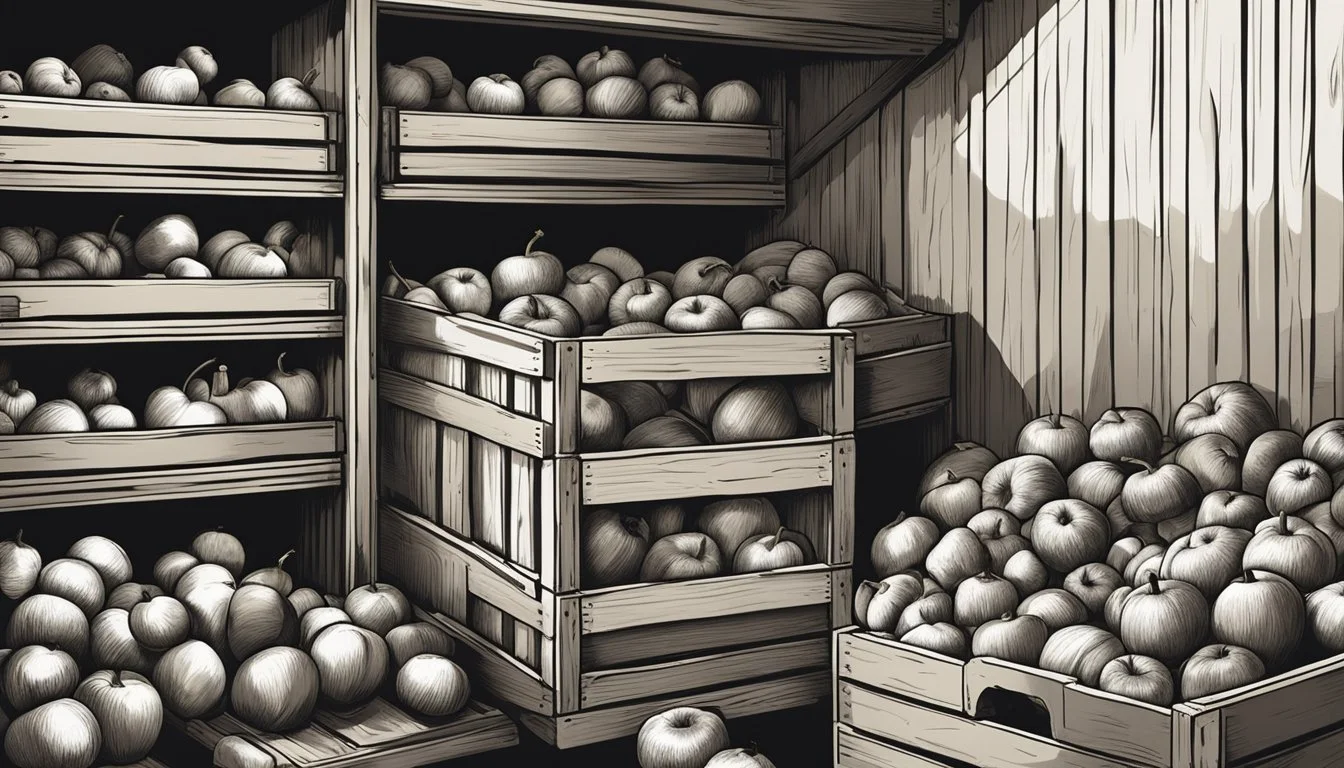Ohio Seasonal Fruit & Vegetables in September
Your Harvest Guide
This Article is Part of our Ohio Seasonal Fruit & Veg Calendar
As summer wanes and autumn approaches, Ohio's agricultural landscape undergoes a vibrant shift. September in Ohio is a transitional month where the bounties of summer harvests meet the early stirrings of fall's offerings. Farmers and gardeners are busy during this period, reaping the benefits of their labor as a wide variety of fruits and vegetables reach their peak ripeness.
The assortment of fruits available in Ohio during September includes late-summer treasures such as the juicy, sweet peaches that have been ripening throughout the warm months. Apples are another highlight of Ohio's September produce; varieties like Honeycrisp, Jonagold, and Red Delicious come into season, offering crisp textures and flavors that range from tart to sweet.
In the realm of vegetables, September also marks the availability of robust options perfect for heartier meals. Tomatoes, while reaching the end of their season, are at their juiciest and are perfect for canning or turning into sauces. Other vegetables like beets present opportunities for both sweet and savory culinary creations. Across the state, local markets and farms showcases an abundance of these seasonal highlights, inviting Ohioans to relish the fresh, locally-grown produce that the region has to offer.
Why Seasonal Eating Matters
Eating seasonally is crucial for maximizing the benefits obtained from fresh produce. This practice supports local farms and ensures that individuals consume fruits and vegetables at the peak of their freshness and flavor.
Benefits of Seasonal Produce
Freshness: Produce harvested during its peak season is fresher, as it's often sold soon after harvest. This freshness can lead to greater nutritional value and taste. For example, tomatoes picked in September to October in Ohio will likely be fresher and tastier than those bought out of season.
Flavor: Seasonal fruits and vegetables grown and harvested during their appropriate times tend to have more flavor. Ohio-grown apples, for instance, are known for being particularly crisp and juicy in the fall.
Support for Local Farms: When consumers choose seasonal items, they are more likely to be purchasing produce from Ohio farms, which helps sustain the local agriculture industry.
Understanding Ohio's Growing Conditions
Climate and Soil: Ohio's climate variations and fertile soil contribute to a diverse agricultural output. The state's growing conditions allow for a wide range of produce, ensuring variety throughout the seasons.
Seasons in Ohio: The distinct seasons in Ohio create a natural production cycle for farmers to follow. In September, farms in Ohio typically offer an abundance of produce like tomatoes, beets, and a variety of apples, all of which thrive in the conditions leading up to Ohio's fall season.
Fruits in Season in September
September in Ohio brings a bountiful array of fruits as the summer heat gives way to cooler autumn air. This transition period allows for the last of the summer fruits and the beginning of fall harvests.
Stone Fruits
Peaches remain a juicy treat in early September but start to dwindle as the month progresses. They represent the tail end of the stone fruit season, with their peak ripeness occurring between July and September.
Berries
While the peak season for most berries has passed, blackberries (how long do blackberries last?) may still be found in early September. They are typically nearing the end of their season, so availability might be limited.
Apples
Apples are the stars of September in Ohio. Various varieties become ready for harvesting throughout the month, including:
Honeycrisp: A sweet favorite, typically picked from September 5 to September 20
Jonalicious: Available around September 10 to September 20
Cortland: A tart variety, best from September 15 to September 30
Golden Delicious: A versatile apple, ripe around September 20 to October 1
Melons
Melons like cantaloupe (how long does cantaloupe last?) may still be available in early September, but their season is concluding. They should be enjoyed quickly before the colder weather sets in and the season comes to an end.
Vegetables Available in September
September marks a robust harvest period in Ohio, showcasing an array of vegetables reaching their peak. Gardens and markets are abundant with mature crops, including corn, tomatoes, and a variety of squash.
Root Vegetables
In September, root vegetables like carrots and beets are ready for harvest. These hardy vegetables have spent the summer growing and are now sweet and full-flavored, perfect for a variety of dishes.
Carrots: Ideal for stews, salads, or roasting.
Beets: Versatile for salads, pickling, or as a cooked side.
Leafy Greens
Leafy greens thrive in the cooler temperatures that September brings. Gardeners can enjoy vegetables like kale, which stands well against the milder frosts and can bring a rich, earthy flavor to the table.
Kale: A nutritious addition to smoothies, sautés, or crisps.
Nightshades and Cucurbits
Nightshade vegetables such as tomatoes and peppers are harvested before the first frost. Crops like squash also fall into the cucurbit family and are ready for picking in September.
Tomatoes: They range from cherry tomatoes to heirlooms, perfect for salads, sauces, and canning.
Peppers: From sweet bell to zesty chili peppers, they add flavor to any dish.
Squash: Includes varieties like zucchini and pumpkin, great for baking or as a savory dish.
Ohio's Fall Harvest Specials
As September ushers in cooler temperatures across Ohio, it heralds the arrival of the state's fall harvest specialties. Consumers can expect a bounty of squashes, pumpkins, and other crops that capture the essence of the season.
Squashes and Pumpkins
Ohio farmers take pride in their diverse variety of fall squashes and pumpkins, which become readily available in September. The squash family offers a range of flavors and uses:
Acorn Squash: Known for its nutty flavor; perfect for baking.
Butternut Squash: (how long does butternut squash last?) Sweet and smooth; ideal for soups and purees.
Kabocha: Also called Japanese pumpkin; has a sweet and fluffy texture, suited for pies and roasting.
Pumpkins are not just for decoration; they are nutritious and versatile:
Pie Pumpkins: Smaller and sweeter, used primarily for baking.
Carving Pumpkins: Although they are predominantly used as jack-o'-lanterns, their flesh can still be used for recipes like pumpkin soup.
Late Summer Crops
Some crops that begin in the summer continue to thrive into early fall, providing fresh produce well into September:
Sweet Corn: A summer favorite, it often extends into the fall harvest season.
Tip: Look for ears with bright green husks and plump kernels.
Tomatoes: Despite being a hallmark of summer, many varieties ripen until the first frost.
Varieties: Heirloom, cherry, beefsteak, for salads, sauces, or canning.
The fall harvest in Ohio is not only a time of abundance but also an opportunity to savor the seasonal flavors that the region has to offer.
Planning Ahead
To ensure a bountiful harvest, it's crucial for Ohio farmers and gardeners to be aware of the peak harvest periods for various crops and to prepare for the transition to the cooler months of October and November.
Harvest Calendar for Ohio
In September, Ohio's farms offer a rich variety of fruits and vegetables ripe for harvesting. Here is a concise guide to what one can expect:
Fruits: September is prime time for apples with varieties like Honeycrisp, Jonathan, Golden Delicious, Red Delicious, and Cortland being in season.
Vegetables: Planting vegetables like lettuce in September takes advantage of Ohio's cooler fall weather, and it's ideal for cold-hardy plants that can grow even in frosty conditions.
Preparing for October and Beyond
Farmers must look ahead to the colder months of October and November and plan accordingly:
Check Variety Growth Times: Match the number of growing days needed with the expected first frost date.
Plant Cold-Season Vegetables: For fall gardens, crops like kale, carrots, and spinach can be planted, which may continue to grow into the cooler months.
Preservation and Storage
In Ohio, the bounty of September's harvest includes a variety of sweet, tender fruits and crisp vegetables. Proper storage techniques ensure these foods maintain their quality throughout the winter months.
Modern Storage Techniques
Modern storage techniques have revolutionized the way one can store fresh produce after harvest. Facilities equipped with controlled atmospheres can extend the shelf life of fruits and vegetables significantly. For instance:
Winter Squash: It can be cured at room temperature for about 10 days and then transferred to cooler storage, around 50-55°F, where it can last for several months.
Apples: Varieties such as Honeycrisp and Golden Delicious benefit from refrigerated storage, with ideal conditions being high humidity and temperatures just above freezing.
Techniques: Utilizing moisture-control systems in storage facilities helps to keep produce crisp. Moreover, proper ventilation is crucial to prevent the buildup of ethylene gas, which can hasten ripening and lead to spoilage.
Through these methods, the textures and flavors of Ohio's September harvest can be preserved well into the colder months, allowing for extended enjoyment of local produce.
Health Benefits of Seasonal Eating
Eating seasonally aligns with the natural cycle of produce, ensuring that fruits and vegetables consumed are at their freshest and most nutritious state. This practice supports overall health by maximizing the nutritional value of the produce.
Nutritional Values of Seasonal Produce
Seasonal fruits and vegetables harvested at their peak contain optimal levels of nutrients. For example, fiber, a crucial nutrient for digestion and heart health, is found in abundance in fresh produce. Vitamins and minerals are also present in higher quantities in fruits and vegetables that haven't been stored for long periods or shipped over long distances.
Fiber: Seasonal fruits and vegetables like apples and leafy greens are high in fiber, promoting a healthy digestive system and providing a sense of fullness, which can help regulate body weight.
Vitamins: Fresh, seasonal produce often has more vitamins. For instance, vitamin C, vital for immune function, is higher in fruits like oranges that are in season during the winter months.
Minerals: Vegetables such as spinach and other dark leafy greens, when eaten in season, offer a rich supply of minerals like iron and calcium which are essential for bone health and blood function.
Choosing to eat seasonally also further advocates for individual health by integrating a variety of fruits and vegetables in the diet, which ensures a wide spectrum of nutrients that the body needs to function effectively.
Locating Seasonal Produce in Ohio
Ohio offers an abundance of fresh, seasonal fruits and vegetables come September. Understanding where to find this produce is essential for tapping into the peak flavors and nutrition.
Farmers' Markets and Farms
Farmers' Markets in Ohio are a prime source for fresh September produce. Shoppers can use the Ohio Department of Agriculture website to locate their nearest farmers' market with an interactive map feature. This ensures a direct connection with local farmers and the opportunity to ask about specific fruit and vegetable availability. U-pick farms also offer a hands-on experience, with schedules often listed on their websites or through social media pages.
Advantages:
Freshness due to minimal transport time.
Supporting local communities and farmers.
Things to consider:
Limited hours of operation.
Seasonal availability may affect stock.
Local Grocery Stores and Co-Ops
Local grocery stores and co-operatives (co-ops) are convenient for finding Ohio-grown produce with clear labels indicating local sourcing. They often partner with regional farms to supply a consistent range of produce, albeit at a potentially higher cost compared to farmers' markets.
Benefits:
Accessibility with more consistent hours.
A wider variety of produce not limited to what's in season.
Points to remember:
While local, not all produce may be from small-scale farms.
Organics and special varieties might come at a premium.
Both farmers' markets and local stores contribute to the distribution of seasonal produce, connecting consumers with the rich agricultural heritage of Ohio.
Conclusion
September in Ohio offers a rich harvest of fruits and vegetables, marking a period of abundance for local produce. One can find a variety of items at their peak freshness and nutritional value during this month. For fruits, apples lead the array with a selection of varieties that include Honeycrisp and Golden Delicious. Peaches round out the stone fruit season, while berries like blackberries and raspberries offer a burst of flavor and antioxidants.
Vegetable gardens are brimming with nutritious greens and roots. Leafy greens such as kale and spinach thrive alongside cruciferous vegetables like broccoli and cauliflower. Root vegetables, including beets and carrots, are also ready for harvest, delivering earthy flavors (What wine goes well with earthy flavors?) and important dietary fiber.
Here are some of the freshest picks one can incorporate into their meals in September:
Fruits: Apples, Peaches, Blackberries, Raspberries
Vegetables: Kale, Spinach, Broccoli, Cauliflower, Beets, Carrots
The abundance of produce not only supports a healthy diet but also encourages seasonal cooking. Chefs and home cooks alike revel in the opportunity to create dishes that reflect the transition of seasons. It is an excellent time for residents to visit farmers' markets, support local agriculture, and enjoy the fresh flavors of Ohio's seasonal bounty.










